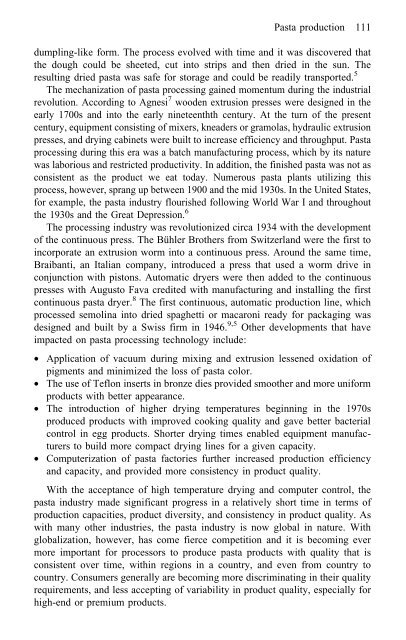Cereals processing technology
Cereals processing technology
Cereals processing technology
Create successful ePaper yourself
Turn your PDF publications into a flip-book with our unique Google optimized e-Paper software.
Pasta production 111<br />
dumpling-like form. The process evolved with time and it was discovered that<br />
the dough could be sheeted, cut into strips and then dried in the sun. The<br />
resulting dried pasta was safe for storage and could be readily transported. 5<br />
The mechanization of pasta <strong>processing</strong> gained momentum during the industrial<br />
revolution. According to Agnesi 7 wooden extrusion presses were designed in the<br />
early 1700s and into the early nineteenthth century. At the turn of the present<br />
century, equipment consisting of mixers, kneaders or gramolas, hydraulic extrusion<br />
presses, and drying cabinets were built to increase efficiency and throughput. Pasta<br />
<strong>processing</strong> during this era was a batch manufacturing process, which by its nature<br />
was laborious and restricted productivity. In addition, the finished pasta was not as<br />
consistent as the product we eat today. Numerous pasta plants utilizing this<br />
process, however, sprang up between 1900 and the mid 1930s. In the United States,<br />
for example, the pasta industry flourished following World War I and throughout<br />
the 1930s and the Great Depression. 6<br />
The <strong>processing</strong> industry was revolutionized circa 1934 with the development<br />
of the continuous press. The Bühler Brothers from Switzerland were the first to<br />
incorporate an extrusion worm into a continuous press. Around the same time,<br />
Braibanti, an Italian company, introduced a press that used a worm drive in<br />
conjunction with pistons. Automatic dryers were then added to the continuous<br />
presses with Augusto Fava credited with manufacturing and installing the first<br />
continuous pasta dryer. 8 The first continuous, automatic production line, which<br />
processed semolina into dried spaghetti or macaroni ready for packaging was<br />
designed and built by a Swiss firm in 1946. 9,5 Other developments that have<br />
impacted on pasta <strong>processing</strong> <strong>technology</strong> include:<br />
• Application of vacuum during mixing and extrusion lessened oxidation of<br />
pigments and minimized the loss of pasta color.<br />
• The use of Teflon inserts in bronze dies provided smoother and more uniform<br />
products with better appearance.<br />
• The introduction of higher drying temperatures beginning in the 1970s<br />
produced products with improved cooking quality and gave better bacterial<br />
control in egg products. Shorter drying times enabled equipment manufacturers<br />
to build more compact drying lines for a given capacity.<br />
• Computerization of pasta factories further increased production efficiency<br />
and capacity, and provided more consistency in product quality.<br />
With the acceptance of high temperature drying and computer control, the<br />
pasta industry made significant progress in a relatively short time in terms of<br />
production capacities, product diversity, and consistency in product quality. As<br />
with many other industries, the pasta industry is now global in nature. With<br />
globalization, however, has come fierce competition and it is becoming ever<br />
more important for processors to produce pasta products with quality that is<br />
consistent over time, within regions in a country, and even from country to<br />
country. Consumers generally are becoming more discriminating in their quality<br />
requirements, and less accepting of variability in product quality, especially for<br />
high-end or premium products.



